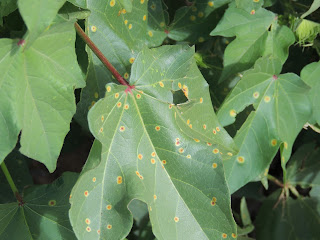 |
Southwestern cotton rust caused by Puccinia cacabata
(Photo: J. Idowu, NMSU) |
Southwestern cotton rust, caused by
Puccinia cacabata, has been found on cotton plants in Southern New Mexico. This disease occurs sporadically in the Southwestern U.S. but has the potential to cause serious economic losses up to 50% under favorable environmental conditions. The disease has a complex lifecycle requiring two different host plants, cotton (
Gossypium spp.) and grama grass (
Bouteloua spp.), to complete a full disease cycle. During summer rains, the spores produced on grama grass germinate to produce airborne spores which are carried up to eight miles and cause initial infections in cotton. There is no repeating spore stage on cotton. All new infections on cotton are dependent upon spore showers from grama grass. The spores produced on cotton can only infect grama grass. Disease incidence is usually erratic in New Mexico and depends on summer rains, high humidity and an infected source of grama grass for inoculum.
 |
Rust lesions on the underside of a cotton
leaf (Photo: NMSU - PDC) |
 |
Rust lesions on the upper (left) and lower
(right) leaf surfaces (Photos: J. Idowu, NMSU,
left; and NMSU - PDC, right) |
 |
Young cotton rust lesions (left) and older cotton rust lesions (right)
(Photos: NMSU - PDC) |





No comments:
Post a Comment